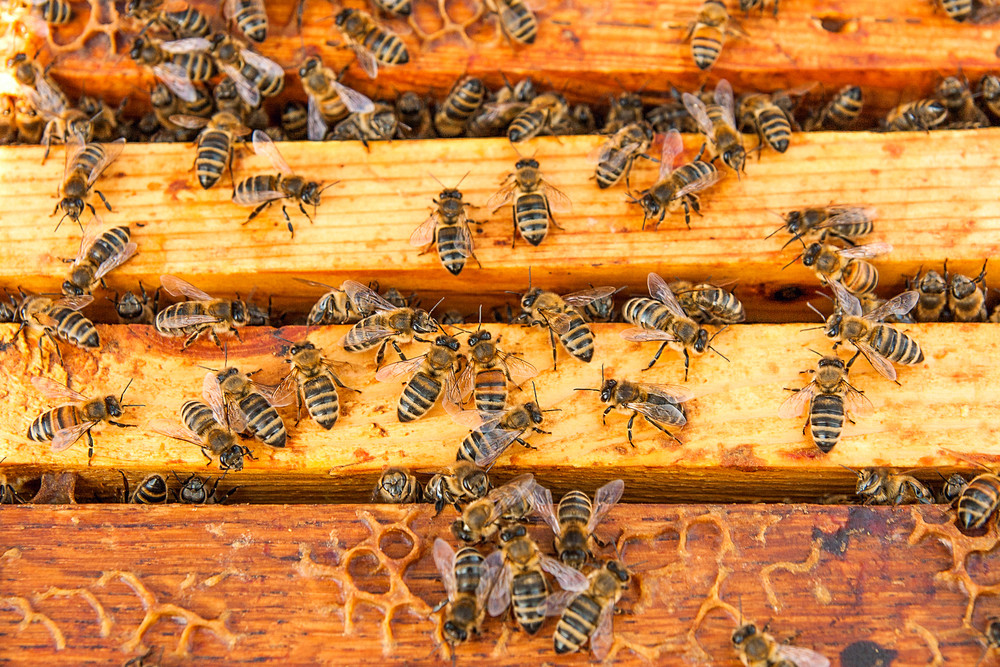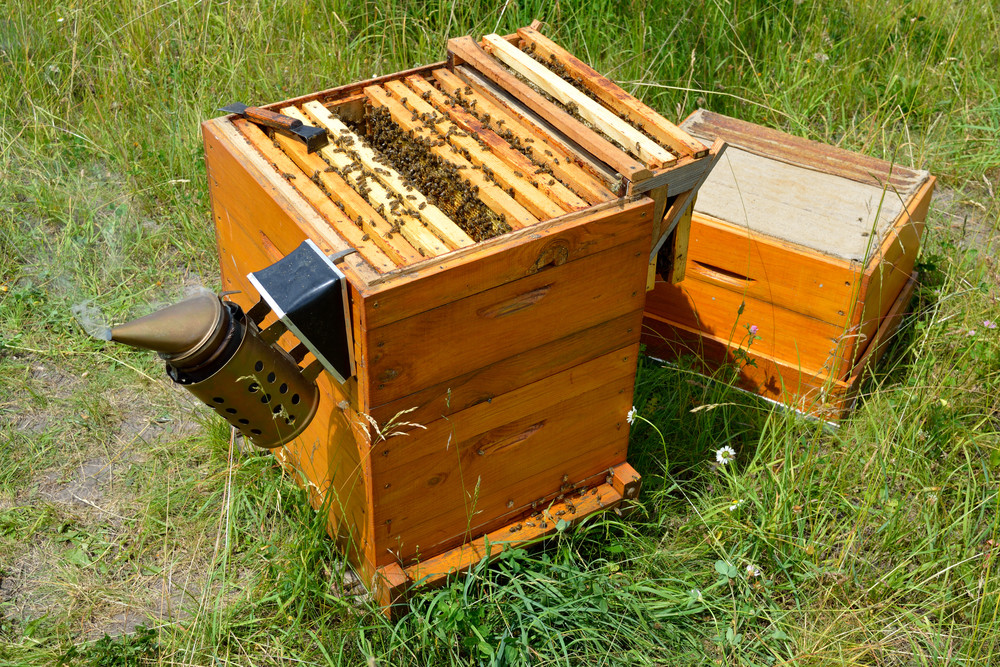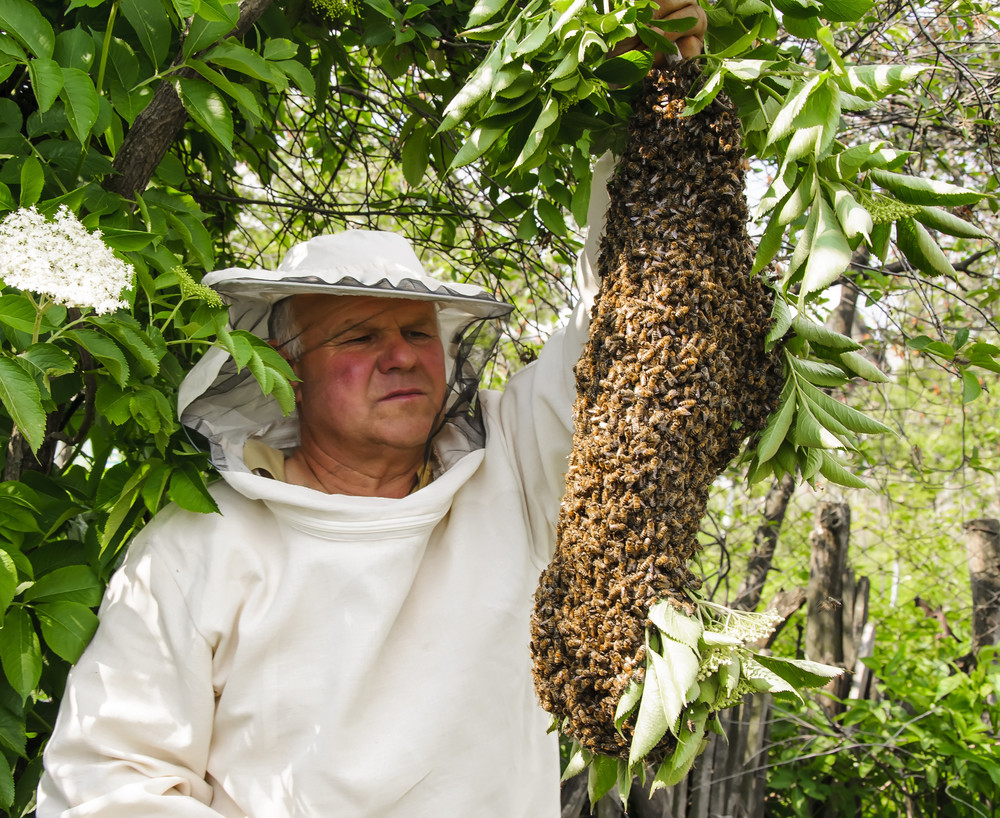
If you’re considering ways to become more self-sufficient, you’ve likely looked at the reasons to raise bees.
Harvesting your own backyard honey sounds like a homesteading dream come true, but is it worth it to start this hobby for yourself? Should you sink some money into a set of hives?
This article will walk you through many of the rewards of raising bees and give you suggestions for how to get started.
Why Raise Bees?
There’s never been a better time to raise backyard bees. Not only are they entertaining and educational to watch, but a hive of honeybees offers impressive pollination benefits for the home garden, especially if you have fruit trees.
Saying that, there are some pros and cons to weigh out carefully before deciding whether you should raise bees. Below are some of those factors.
The Pros:

Help Save Bees: Bees perform close to 80% of pollinating globally, but their populations have been on a sharp decline for more than a decade.
It’s not completely clear what’s causing the die-off, but you can work to rebalance your local community of pollinators by tending to a hive.
(Learn more about how you can help save bees here)
Harvest Homegrown Honey: There’s no better honey than what you harvest straight from the backyard, and so long as you manage things properly you can ensure that there’s enough for both you and your bees to make it through the winter.
It takes twelve bees to produce a teaspoon of honey over their lifespans, but having a hive of hundreds means this honey adds up fast.
Fresh Wax Supply: A byproduct of honey production is beeswax, as worker bees form it into honeycombs to create the structure of their home.
There are endless uses for beeswax, including making candles, body balms, and other projects. Maintaining your own hives gives you a ready supply.
Boost Your Backyard Food Potential: For those with home gardens and orchards, honeybees and other pollinators are essential for fruit production.
Having a hive or two near your fruiting plants ensures that bees will visit them during their nectar search and pass on pollination benefits in the process.
Little Work From You: Once you set up a beehive, the local inhabitants quickly earn their reputations for being as “busy as bees.”
You won’t need to do much to maintain your hive, as it typically takes an hour or less a week to ensure everything is operating as it should.
However, if you live in a colder climate, it requires more effort to help your bees survive the winter.
The Cons

There are some downsides to raising honeybees that are worth knowing before you dive into this hobby. Below are several factors to keep in mind.
Honeybees aren’t Native: It’s believed that honeybees originated in Africa, but they have been spread across their globe through the help of humans for their honey production potential.
This means that your hive of honeybees might out-compete the native bees and other pollinators in your area, potentially causing their populations to fall.
You Might Get Stung: Honeybees aren’t the most docile of livestock, and almost every beekeeper needs to be prepared for the occasional sting. If you are sensitive or allergic to stings, this probably isn’t the smartest hobby for your situation.
Beekeeping isn’t Cheap: While many people find that the joy of beekeeping pays for itself, the rest of us discover that maintaining hives is an expensive proposition.
You’ll pay hundreds of dollars for your first hives, and clothing and other gear will likely cost several hundred more.
If you’re looking to cut costs, it’s usually not worth compromising on lower quality equipment. Instead, look for people getting out of the hobby who might be willing to cut you a deal on their used equipment.
Die-Offs Happen (A Lot): Even if you do everything right, there’s still a chance your bees might not make it. That’s because a young hive has a lot to do their first year, including producing wax, finding enough honey for the winter, and raising the next generation.
It’s a common complaint that whole hives dive over the winter, so you need to be prepared to start over.
Your Bees Might Get Sick: Today’s bees face a lot of threats, and a number of diseases, pesticides, and parasites can do them in.
You’ll need to stay aware of the symptoms and prevention practices so that you can ensure that your hive stays healthy.
Top Beekeeping Tools For Getting Started

If you’re still interested in raising your own bees after seeing this pros and cons list, then it’s time to start considering the equipment you’ll need. The first big decision you need to make is about hive variety.
There are three main types of hives to consider: the Langstroth hive, the top bar hive, and the Warre hive.
Langstroth hives are the most common type used today, and they are considered beginner friendly. They consist of removable frames that are stacked on each other for easy access.
Considered to be one of the oldest hive designs in the world, top bar hives feature wooden bars laid out on the top of the bar and a protected interior for the bees to build their comb in.
These hives are easier on beekeepers backs because they don’t require you to stack heavy boxes on top of each other.
However, you need to remove the comb to extract the honey which means that the bees will need to rebuild it each year.
The Warre hive is a vertical top bar hive, as it consists of identical stacked boxes placed on top of each other.
Most beekeepers who use this style tend to put empty boxes on the bottom of the hive to better mimic how bees create habitat space in the wild.
Beyond the hive, you will also need a variety of beekeeping equipment, including protective clothing, frame grips for removing frames for harvest, a hive smoker (to sedate the bees and prevent stings), and a honey refractometer to test its quality.
Beginners might want to invest in a starter kit to get the basics all at once.
Where To Get Honey Bees

Once you have your hives established, it’s time to think about securing your bees. Buying bees tends to be the most popular method for beginners, and the two common ways to receive them are as a package of bees or a nucleus hive.
As the name implies, a package of bees contains a queen and worker bees that you can incorporate into your hive.
It’s usually best to buy package bees locally, though they should be fine in the container for a few days because they typically come with a sugar syrup feeder.
With this method, the queen bee usually arrives in her own special cage that keeps her safe from the workers.
Once all the bees are in the hive, the worker bees will slowly eat through the food plug in her care to release her.
A nucleus hive, in contrast, is a half-size colony with a queen and baby bees (called a broad).
This gives you a jump start on starting a hive, but it’s slightly more precarious because you have a higher risk of spreading pests or disease into your new colony.
For those who are daring, it’s also possible to capture a swarm in the wild to re-home in your hive.
Bees tend to divide up their colonies when they grow too big, so swarming is a natural instinct for half the bees to leave with a new queen and reestablish themselves.
Most bees tend to swarm in the spring, so it might be worth looking for tree limbs covered in bees that you can then cut down and deposit into a container.
Just make sure you wear protective clothing and use a smoker to keep them calm. This should only be done if you know what you are doing or have an expert there to assist you.
How To Harvest Honey From A Backyard Hive

Once you’ve established your hive, it’s time to start making a honey harvesting plan.
Keep in mind that keeping bees is a commitment, as you’ll need to wait until at least the second year for the bees to produce enough honey to spare.
Bees only produce honey when they have access to abundant flowers for long periods, so you’ll tend to get more honey if you live in a warm climate and ensure your backyard contains a variety of flowers that bloom throughout your entire growing season.
So long as you give your hive the time and resources to create stellar honey, the supply will be well worth the wait.
The average colony in a flower-rich region produces enough honey for a beekeeper to harvest more than four gallons, but this amount can vary significantly by year and location.
Harvesting honey is a delicate process because you don’t want to disturb your bees or harvest honey to the point that they can’t make it through the winter.
For that reason, it’s best to harvest honey with an experienced beekeeper for your first few attempts so that you can learn the nuances.
The specific steps you will need to follow will depend on the hive you have, but below is the basic technique.
- Open the hive: Use a smoker to puff smoke into the hive entrance so that you sedate your bees and drive them into a corner of the hive. You’ll then carefully remove the inner cover to gain access to the inside. Note: Too much smoke can affect the honey’s flavor, so use it sparingly!
- Pull Bees Off the Frame: Before you can pull out frames, you need to remove lingering bees from them with a “bee brush” to get them back into the cave.
- Puncture the Honey Caps: Once you have a free comb, you will need to remove the beeswax seals from the comb with an uncapping knife by slicing through the top layer. Don’t throw away these cappings, as you can transform the beeswax through a variety of homesteading projects.
- Extract the Honey: You’ll next put the honeycomb in a honey extractor (hand crank or electrical models both work). Extractors use centrifugal force to spin the hives and pull the honey from the combs so that it drips off the sides to the bottom where it is released through a spigot.
- Filter the Honey: Once you have a large amount of raw honey, you will want to strain it through several layers of cheesecloth to remove stray wax and debris, and then let it set for a few days so that any contaminants settle at the bottom and can be poured out. From there, you can bottle it with clean, sterilized bottles.
Once bottled, you can return the used comb to the hive for the bees to replenish it. It’s possible to start enjoying your homemade honey immediately.
3 Final Tips To Keep In Mind for Raising Bees

There’s a lot to learn about keeping honeybees that we can’t cover here, but below are three final tips to keep in mind before you commit to this challenging yet rewarding hobby.
1. Know Your Local Laws:
Not all areas are conducive to beekeeping, and some cities have restrictions and regulations you need to know in advance.
Some places ban beekeeping altogether, and in others you will need to register your hive and potentially pay a fee.
It’s also smart to check in with your local community to make sure keeping bees won’t cause problems for anyone else.
After all, you don’t want to invest in hives only to find out a local five-year-old is deathly allergic!
2. Think Like A Bee In Flight:
The term “beeline” means to travel in the most direct route, which is precisely what a bee will do when it senses food.
You’ll want to think through this fact during hive placement so that you can ensure that bees won’t be flying over problem areas to get to food sources.
If you don’t want bees traveling around a pathway that humans take, consider installing a fence near the hives so that the bees are encouraged to fly high quickly and stay above people who don’t want to be stung.
3. Make Bee Food Plentiful:
One of the best ways to ensure you have success with bees is to ensure they have a ready food supply all summer long.
Plant lots of flowers (preferably native) and focus on varieties that will bloom at different times of the year so that you can guarantee your bees a nectar supply from spring to fall.
There’s a lot to think about when deciding if you should raise bees.
Weigh out the decision carefully before you start investing in equipment, and there’s a good chance you’ll find a lot to like about this highly rewarding hobby.
This article has only touched on the basics of beekeeping. For further information, we recommend these books:
- How to Raise Backyard Honey Bees by Isaac Miller
- Storey’s Guide to Keeping Honey Bees by Richard E. Bonney
- Backyard Beekeeping by Olivia Abbey
Pin This To Save For Later

